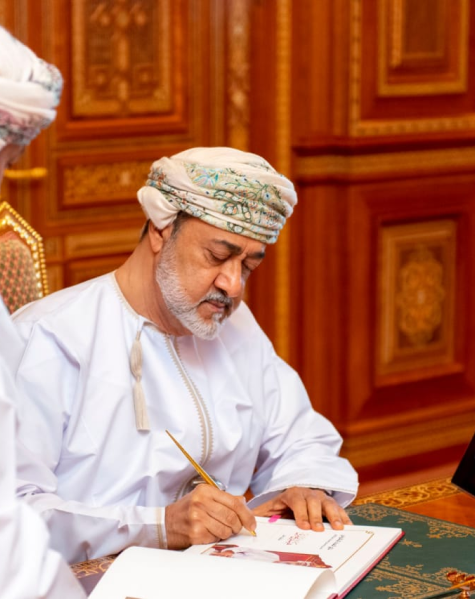
Case study
Oman embraces digitalization by completing a fully register-based census
In today’s ever-changing world, where data-driven decision-making is key, a census is one of the most critical surveys a state conducts. At the end of a tumultuous year of COVID restrictions and lockdowns in 2020, the Sultanate of Oman completed a fully register-based census on their first try. Thus, allowing the country to run a one-click census at any time and react to population changes quickly and efficiently.

Government innovation
The evolution of the census
Throughout time, census data has been used to inform and direct policy. However, how censuses are conducted has changed with the advancement of technology.
In 1440, the Incas, who didn’t have a written language, used a system of knots on strings made from llama or alpaca hair to record census data and administer their empire.
In 2020, 580 years later, Oman conducted a fully-register-based census with all three registries on their first try. Oman’s method was even highlighted by the United Nations Population Fund (UNPF) as an international model of shifting from a traditional census to a register-based census.
In the past 20 years, Oman has put a strong emphasis on digitalization. As a result, the country’s eGovernment Development Index has risen from 0.3548 (rank 98) in 2003 to 0.7749 (rank 50) in 2020. The one-click census is another excellent example of this digital transformation journey.
1993
Civil register established
2003
National Strategy for Digital Society and eGovernance
2009
National Data Centre (NDC) inaugurated
2010
Oman National Computer Emergency Readiness Team (OCERT) launched
2012
Digital Transformation program commences
2014
Government cloud G-Cloud launched
2016
Invest Easy portal launched
2017
Tax Management System for Corporate Income Tax implemented
2018
e-Justice System “Tawtheeq” launched
2020
First e-Census completed
Challenge
The transformation of the census in Oman
Oman conducted its first census in 1993, with subsequent censuses in 2003 and 2010. The traditional census has two main drains — time and money. It costs a lot to conduct and takes time to get the results.
The 2010 census combined door-to-door visits by enumerators and an online questionnaire. In total, close to 6,600 people were involved in the process, with costs ranging from salaries, transportation, and per diems to post-census analysis and publication costs. In addition, much of the data entry and processing was manual, opening it up to errors.
For the 2020 census, Oman was forward-thinking and embraced innovation fully. We worked closely with the National Center for Statistics and Information to create a data processing strategy, architecture design and to develop the e-Census project. As a result, the Sultanate became one of a few countries at a global level and the first in the Arab world to conduct a census that relied entirely on data collection through administrative records. The data obtained and the indicators provided by the census are vital for enhancing Oman Vision 2040 and have important implications for the developmental planning of all sectors of the Sultanate.
– Taavi Einaste, CEO, Middle East and Africa
Oman’s successful fully register-based census is a huge step toward real-time decision making, which on a national level can lead to better efficiency, quicker policy-making, and happier people.
Solution
A fully register-based census
This approach takes advantage of the input received from various administrative registers. The data is cross-referenced using advanced extract, load, and transformation practices to obtain the necessary information for census readiness.
A key goal of the e-Census 2020 project was to implement population, housing, and establishment hubs that update in near real-time — as soon as an entry is made into the administrative registers. Together with the ambitious team at National Center of Statistical Information (NCSI), Nortal successfully established common data exchange standards, which were used by 24 administrative registers that provided data for the census.
Using state-of-the-art technology, the e-Census 2020 solution can ingest millions of records from various administrative registers. Statistical classifications are applied using the metadata, followed by technical and logical data validation checks. The statistical authority in Oman works with aggregated data, therefore maintaining the privacy of its citizens and residents.
Eventually, census methodology is applied to the data from registers, and geospatial data is processed to support the census. The output is then disseminated through the e-Census online portal.
The entire process is fully automated, enabling Oman to execute an on-demand census at any time.
4.5m
People counted
95%
Data quality
100m+
Records processed
Impact
First in the Arab world
On December 14, 2020, His Majesty Sultan Haitham Bin Tarik endorsed the results of the e-Census 2020 of Population, Residences and Establishments, which showed that as of December 12, 2020 the population of the Sultanate stood at 4,471,148. Despite the outbreak of COVID-19, the e-Census 2020 was executed on schedule.

Oman became the first nation in the Arab world to count successfully and simultaneously all three of its main registers in a single census on the first attempt. The United Nations Population Fund describes Oman’s census as a global model for the transition from traditional censuses based on field surveys to censuses based on national administrative records.
Oman’s fully register-based census boasted data quality of 95%, with more than 100 million records processed. It has been theorized that about 23 million USD was saved by switching to a fully-register-based census, most of which resulted from having just 74 employees working on the census compared to 6,000+ staff in 2010.
Oman became the first country in the GCC to achieve a 100% register-based census in 2020.
1st
1st nation in the Arab world to count successfully and simultaneously all three of its main registers on the first attempt.
23m
About 23 million USD was saved by switching to a fully-register-based census.
74
Only 74 employees worked on the 2020 census compared to 6,000+ staff in 2010.
The foundation of a proactive government
The e-Census is only the first step. It provides policymakers with crucial information for understanding population changes in different regions and categories to be able to plan for the future.
Furthermore, it allows the government to communicate with its citizens proactively, based on their needs, preferences, and life events, such as marriage or birth of a child. For example, birth data allows the government to automatically share information about benefits and other helpful information for new parents. Or in relation to higher education, the government can use data about university students and their specializations to plan jobs and other employment enablement plans for the youth entering the job market.
Designing and implementing proactive services allows the government to increase engagement and offer excellent value to its citizens and residents.
– Tomy Bosco, Business Area Director
It has been a real privilege to work on this project with the NCSI and the Sultanate of Oman. I think Oman is a true global trailblazer – demonstrating how technology can accelerate and enable public services.

Transforming governments, transforming societies
The right digital tools applied properly can dramatically transform citizen-government interaction, changing the way societies work.
A digitally-enabled government is citizen-centric, proactively meeting needs when it comes to social security and taxation. It literally changes the way citizens interact with and experience their government.
Find out moreGet in touch
Let us offer you a new perspective.


